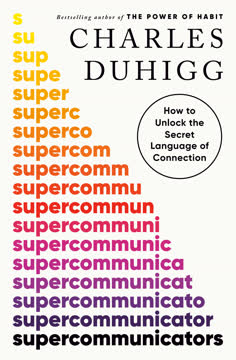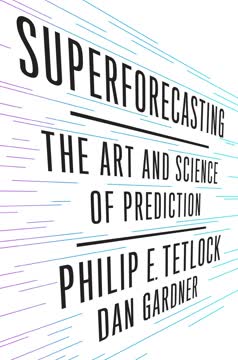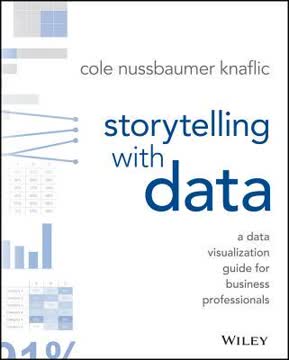Key Takeaways
1. Data Storytelling: Transform Numbers into Compelling Narratives
"Data doesn't speak for itself; it needs a storyteller."
Storytelling power: The human brain is wired to process stories, making them a powerful tool for communicating data. By transforming data into vivid scenes and structuring delivery in the shape of a story, you make your audience care about what the data says.
Memory and emotion: Stories are more memorable than raw facts. In a study by Chip Heath, only 5% of students could recall specific statistics from speeches, while 63% remembered the stories. This is because stories activate emotions, making them stick in our minds.
Beyond raw numbers: Data storytelling isn't just about presenting numbers; it's about:
- Uncovering insights
- Providing context
- Inspiring action
- Creating meaning
- Driving decisions
2. Empathy is Key: Understand Your Audience and Decision-Makers
"The foundation of effective communication is empathy."
Know your audience: Tailor your message to those receiving it. What may seem clear to you could be perplexing to others. Understanding your audience's background, knowledge level, and preferences is crucial for effective communication.
Executive communication: When presenting to executives:
- Respect their time – they are incredibly busy
- Understand how they are measured (revenue growth, market share, etc.)
- Know their preferred communication style
- Be prepared for interruptions and questions
- Structure your message for quick consumption
Soft skills matter: Communication skills are in high demand. A LinkedIn study found that out of a 1.6 million soft skills gap:
- 993,000 required oral communication skills
- 140,000 required writing skills
3. Craft a Clear Data Point of View (DataPOV) to Drive Action
"Your DataPOV is the centerpiece of your entire recommendation, and all other material you present stands in support of it."
Structure of a DataPOV:
- Your unique point of view requiring action
- What is at stake (positive and negative)
Write it clearly: Express your DataPOV in a complete, well-constructed sentence with at least one noun and one verb. This becomes the title page of your recommendation.
Choose strong verbs: The action verb in your DataPOV is crucial. It should fall into one of three modalities:
- Change: We need to change who we are or what we're doing
- Continue: We need to keep going in the same direction
- Finish: We need to complete this
Examples of strong verbs:
- Performance verbs: accelerate, decrease, improve, scale
- Process verbs: implement, optimize, streamline, innovate
4. Structure Your Data Story for Maximum Impact
"Leveraging the structure of a story arc makes an executive summary engaging and memorable, and it actually reads much like a story."
Three-act structure: Organize your data story into three acts:
- Beginning: Introduce the current situation, problem, or opportunity
- Middle: Present the messy data that needs to change
- End: Your DataPOV addressing the problem and creating a positive outcome
Recommendation Tree: Use a logical structure to support your DataPOV:
- Main point (DataPOV)
- Supporting point 1
- Evidence
- Evidence
- Supporting point 2
- Evidence
- Evidence
- Supporting point 3
- Evidence
- Evidence
- Supporting point 1
What-Why-How model: For each supporting point, answer:
- What needs to be done?
- Why is it important?
- How will we accomplish it?
5. Choose Simple, Effective Charts and Annotate Insights
"For gaining buy-in, clarity always outperforms cool."
Stick to basics: Use familiar chart types that everyone understands:
- Bar charts (for quantities)
- Pie charts (for parts of a whole)
- Line charts (for trends over time)
Write clear observations: Use descriptive language to highlight insights:
- For bar charts: Use adjectives to describe size differences (largest, smallest, higher, lower)
- For pie charts: Use adjectives to describe proportions (majority, minority, significant)
- For line charts: Use adverbs to describe trends (rapidly, steadily, sharply)
Annotate for impact: Use visual annotations to draw attention to key points:
- Highlight data points with contrasting colors
- Add large, graphical labels to important numbers
- Use brackets or boxes to show calculations
- Overlay benchmark lines
- Explode data to show subcategories
6. Make Data Relatable Through Comparison and Context
"To help your audience understand the magnitude of the data, compare it to things that are familiar to them."
Develop a sense of scale: Help others grasp large or small numbers by comparing them to relatable concepts:
- Size: "One million squares would fill almost 31 pages."
- Time: "One million seconds is 11.57 days."
- Distance: "A million millimeters is one kilometer (about 12 New York City blocks)."
Use familiar comparisons:
- Length: Your height, a credit card, the width of a car lane
- Area: Football field, city block
- Volume: Building, Olympic swimming pool
- Time: Work hours, flight duration, TV episode length
- Speed: Walking pace, speed limits
Add context: Provide additional information that gives your data new meaning or reveals unexpected results.
7. Humanize Data by Identifying Heroes and Adversaries
"Most organizational data wouldn't exist without humans generating it."
Find the human story: Look for the people behind the data points. Who are the customers, employees, or stakeholders affected?
Identify conflict types:
- Hero vs. Self: Internal struggles (fear, bias, values)
- Hero vs. Person: Conflicts with others (customers, regulators)
- Hero vs. Society: Challenges against institutions or norms
- Hero vs. Technology: Struggles with systems or processes
- Hero vs. Nature: Battles against external forces (diseases, disasters)
Speak with characters: To truly understand the story behind the data:
- Read forums and customer comments
- Conduct surveys
- Interview a sample of your "data heroes"
- Ask open-ended questions to uncover motivations and challenges
8. Use Storytelling Techniques to Reveal Data Dramatically
"Make your DataStory truly come alive by creating suspense and telling an intriguing story with some elements of mystery."
Create suspense: Strategically withhold key features of your findings to build anticipation.
Surprise techniques:
- Add context: Reveal additional information that changes the meaning of data
- Zoom in or out: Uncover hidden features by adjusting the scale or focus
Dramatic reveals: Use presentation software to:
- Reveal chart elements one at a time
- Use transitions to zoom in or out of data
- Hide additional screens or data for a shocking reveal
S.T.A.R. moments: Create "Something They'll Always Remember" by using unexpected visuals or props to emphasize key points.
9. Leverage Emotional Arcs in Data Presentation
"If you have a chart that ends in good fortune, you can reveal each bar (or line segment) one at a time."
Six basic emotional arcs:
- Rags to Riches (steady rise)
- Man in a Hole (fall then rise)
- Cinderella (rise, fall, then rise)
- Tragedy (steady fall)
- Icarus (rise then fall)
- Oedipus (fall, rise, then fall)
Apply to data presentation:
- For positive outcomes: Build suspense by revealing data points sequentially, ending with good fortune
- For negative outcomes: Clearly explain the cause and address it directly
- For reversible negative trends: Position the audience as heroes who can change the outcome
Create catharsis: When presenting data that ends in ill fortune, help the audience learn from mistakes and feel motivated to take action.
Last updated:
FAQ
What's "DataStory: Explain Data and Inspire Action Through Story" about?
- Combining Data and Storytelling: "DataStory" by Nancy Duarte focuses on the integration of storytelling techniques with data presentation to inspire action and lead effectively.
- Structure and Communication: The book provides a framework for structuring data into a narrative that is engaging and memorable, using a three-act story structure.
- Empathy and Connection: It emphasizes the importance of empathy in communication, ensuring that data is presented in a way that resonates with the audience.
- Practical Techniques: The book offers practical advice on crafting executive summaries, choosing the right charts, and making data visually consumable.
Why should I read "DataStory"?
- Enhance Communication Skills: The book is essential for anyone looking to improve their ability to communicate data effectively and persuasively.
- Leadership Development: It is particularly useful for those in leadership roles who need to make data-driven decisions and inspire their teams.
- Actionable Insights: "DataStory" provides actionable insights and techniques that can be applied immediately to improve data presentations.
- Empathy-Based Approach: The book's focus on empathy ensures that data is not just presented but is also understood and acted upon by the audience.
What are the key takeaways of "DataStory"?
- Story Structure: Use a three-act story structure to make data presentations more engaging and memorable.
- Empathy in Communication: Tailor your message to the audience's needs and background to ensure clarity and understanding.
- Visual Clarity: Choose simple, familiar charts and use annotations to highlight key insights without overwhelming the audience.
- Action-Oriented Data: Formulate a clear Data Point of View (DataPOV) that includes a recommended action and the stakes involved.
How does Nancy Duarte suggest transforming numbers into narratives?
- Identify the Story: Recognize the story emerging from the data, as data alone does not speak for itself.
- Engage the Audience: Use vivid scenes and a structured delivery to make the audience care about the data.
- Memorability: Stories are more memorable than statistics; use storytelling to activate emotions and improve recall.
- Avoid Fiction: While using storytelling techniques, avoid incorporating creative fiction into data presentations.
What is the Data Point of View (DataPOV) in "DataStory"?
- Definition: A DataPOV is a structured statement that combines a unique point of view with a required action based on data insights.
- Structure: It should be a complete sentence that clearly states the action to be taken and what is at stake.
- Central Role: The DataPOV serves as the centerpiece of the entire recommendation, guiding the narrative and supporting evidence.
- Clarity and Ownership: It requires the communicator to own their perspective and articulate it clearly to drive action.
How does "DataStory" recommend structuring an executive summary?
- Three-Act Structure: Use a beginning, middle, and end to structure the executive summary as a DataStory.
- Act 1 - Situation: Introduce the current situation and the problem or opportunity identified in the data.
- Act 2 - Conflict: Highlight the messy middle, where data presents problems or opportunities that need addressing.
- Act 3 - Resolution: Conclude with the DataPOV, proposing a solution and the positive outcomes of taking action.
What are the best quotes from "DataStory" and what do they mean?
- "Oh, the stories data would tell, if there were a teller to tell them well." This quote emphasizes the importance of a skilled communicator to bring data to life through storytelling.
- "Action is the foundational key to all success." This quote by Pablo Picasso, included in the book, underscores the importance of taking action based on data insights.
- "Tell me the facts, and I’ll learn. Tell me the truth, and I’ll believe. But tell me a story, and it will live in my heart forever." This Native American proverb highlights the lasting impact of storytelling compared to mere facts or truths.
- "Good design is good business." This quote by Thomas Watson, Jr. reinforces the idea that clear and effective communication, including data presentation, is crucial for business success.
How does "DataStory" suggest choosing charts and writing observations?
- Simple Charts: Use bar, pie, and line charts that are familiar and easy for everyone to understand.
- Clear Titles: Write factual and neutral chart titles that convey what, how, and when the measurement happened.
- Descriptive Observations: Add observations to charts using adjectives for static data and adverbs for trends to highlight key insights.
- Visual Annotations: Use visual elements like highlights, labels, and brackets to make data points stand out and add clarity.
What is a Slidedoc™ according to "DataStory"?
- Definition: A Slidedoc is a visual document designed for quick consumption, combining the strengths of a document with the advantages of visualization.
- Purpose: It is intended to be read and distributed rather than presented, making it ideal for conveying detailed information concisely.
- Structure: Slidedocs should be modular, with one idea per slide, allowing for easy skimming and comprehension.
- Distribution: They are effective for spreading ideas within an organization, as they can be easily shared and adapted.
How does "DataStory" recommend making data stick?
- Relatable Comparisons: Attach data to something relatable, such as size, time, or familiar objects, to help the audience understand magnitude.
- Humanize Data: Identify the heroes and adversaries in the data to create a narrative that resonates with the audience.
- Emotional Connection: Use storytelling techniques to evoke emotions and make data memorable and actionable.
- Contextual Meaning: Provide context to data points to add meaning and make them more relevant to the audience.
What role does empathy play in "DataStory"?
- Foundation of Communication: Empathy is the foundation of effective communication, ensuring that the message is tailored to the audience's needs.
- Understanding the Audience: Recognize the different backgrounds and knowledge levels of the audience to present data clearly and effectively.
- Building Connection: Empathy helps build a connection between the storyteller and the audience, making the data more engaging and persuasive.
- Driving Action: By understanding the audience's perspective, communicators can craft messages that inspire action and drive change.
How does "DataStory" address communicating to decision-makers?
- Know Your Audience: Tailor the approach to the decision-maker's preferences and authority level, using structured and brief communication.
- Respect Their Time: Executives are busy, so recommendations should be concise, logical, and easily skimmable.
- Anticipate Questions: Be prepared for interruptions and questions, as executives will challenge information to gain clarity.
- Understand Their Measures: Recommendations should align with executive performance levers, such as growth, efficiency, and innovation, to ensure relevance and approval.
Review Summary
DataStory receives mostly positive reviews for its insights on data presentation and storytelling. Readers appreciate the practical advice, examples, and visual design. Many find it useful for improving presentations and communicating data effectively. Some criticize it for being too basic or sales-oriented. The book is praised for its frameworks, particularly the three-act structure for data stories. While some experienced professionals find it elementary, others see it as a valuable reference guide for data visualization and storytelling techniques.
Similar Books










Download PDF
Download EPUB
.epub digital book format is ideal for reading ebooks on phones, tablets, and e-readers.







